
Written by digiDirect
Like most creative pursuits, the guiding principles of photography include a broad set of rules. Many of these rules or guides are standards for achieving the best possible composition. Some of them are complex, incredibly demanding and questionable as to their actual value.
The most widely known and understood rule for elemental photographic composition is the rule of thirds.
The rule of thirds is not just a photographic tool. Utilised by creative painters centuries ago, it allowed for more exciting framing of subjects. The introduction of this concept was a big leap that resulted in more dynamic and contemporary forms of painting.
You may think that as long as your subjects are showing up in your frame of view, then you can take the image. Of course you can, but will the image be visually balanced? Will your image naturally draw the viewer's eye around the entire scene? And will your points of interest be best represented?
The rule of thirds is a simple composition tool that will ensure you make your photographs more visually balanced and dynamic. Further to this, it will engage viewers in the entire scene and tell more of a story.

The Rule of Thirds is a compositional concept that breaks your photos up into 9 equal sections
What are Points of Interest in a Composition?
Understanding how points of interest can appear in your scene is critical to being able to apply the rule of thirds.
Points of interest are critical features within your composition that you want to highlight or use to give impact to your image. It can take some practice to identify the points of interest in different photography settings. Rather than just seeing the scene as a whole, you need to identify critical points of interest within the scene.
Further to this, you need to see where they place in the overall composition. A good starting question is to consider if they are in the foreground or background? Also, ask yourself how the points of interest interact with the rest of the scene? You need to understand these basics before you can apply the rule of thirds.
Landscape Points of Interest
In a landscape setting, the points of interest may all appear in the background. For example, a mountain range that runs along the horizon line of the composition. In this case, you may think that framing the whole scene is enough to capture a great image.
However, looking for points of interest will change how you frame the shot. Ask yourself: are there standout peaks in the mountain range? Is there an unusual pattern forming in the clouds in the sky? What is happening in the foreground? Perhaps dead trees are sticking out of a lake?
Looking for these sometimes subtle elements can take some practice and a few moments of fore-thought before you even touch the shutter button.
Travel Photography Points of Interest
In a travel scenario, you may come across a city scene with lots of old brick buildings, pavers and statues or fountains - imagine a European town plaza. Take the time to view every element of the scene to gather your points of interest. If you are shooting a general street scene, then look for how the lines of the buildings interact with the road.
You should also consider if you can incorporate statues or fountains as foreground points of interest. Pay attention to where they they sit in the frame and whether you are in the best location to capture them. Use your feet and eyes to consider what the composition could be well before you bring the camera to your eye.
Portrait Photography Points of Interest
A further example would be the use of photography to capture images of people. If the photos are modelling headshots or pictures of people within a setting, look for the points of interest. In tight headshots, typically the eyes are the most engaging points of interest.
If photographing full-body images, then it is always critical to be aware of where you are placing your subject in the scene. Be sure to understand how the two interact as you may not want the scenery to overtake the subject. A point of interest may be something that the subject is interacting with, such as a product or device.
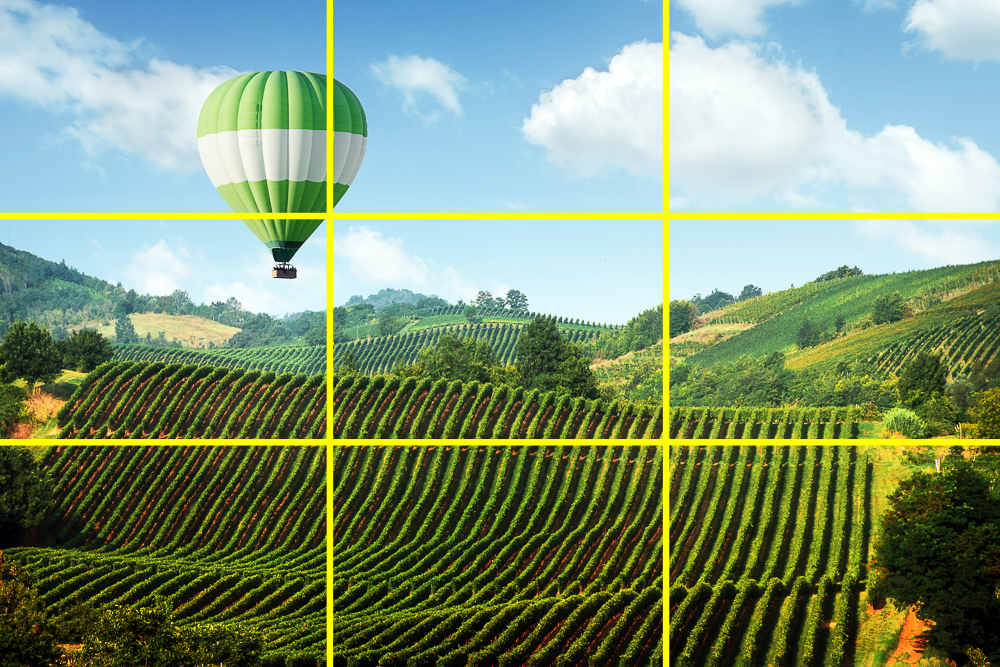
Identifying the points of interest in your photo will allow you to align them in the frame in a pleasing way
What is the Practical Application of the Rule of Thirds?
In photography, it is straightforward to apply the rule of thirds when you are composing an image. It just takes a little time and practice to get the hang of it before you become a composition master.
The rule of thirds allows you to break up your frame into nine equal-sized blocks with two vertical and two horizontal guiding lines. The points where the axis intersects, known as the four intersecting points, provide a guide on where to position the points of interest in your composition. It can be a little tricky to imagine this grid system sitting in front of you at first.
To simplify the process, look through your camera viewfinder or LCD screen to see a more compressed version of the scene. Now imagine the gridlines that you see on the image below superimposed on the photo. Notice how you have four points of intersection - top left, top right, bottom right and bottom left of the view. Remember that the points are where the gridlines intersect one another.
If you are lucky, your camera may even have the functionality to overlay a rule of thirds grid through your viewfinder or screen. If so, then you have a supporting guide to using the rule of thirds. If not, you need to have a little more practice to imagine how the rule of thirds applies to a scene.
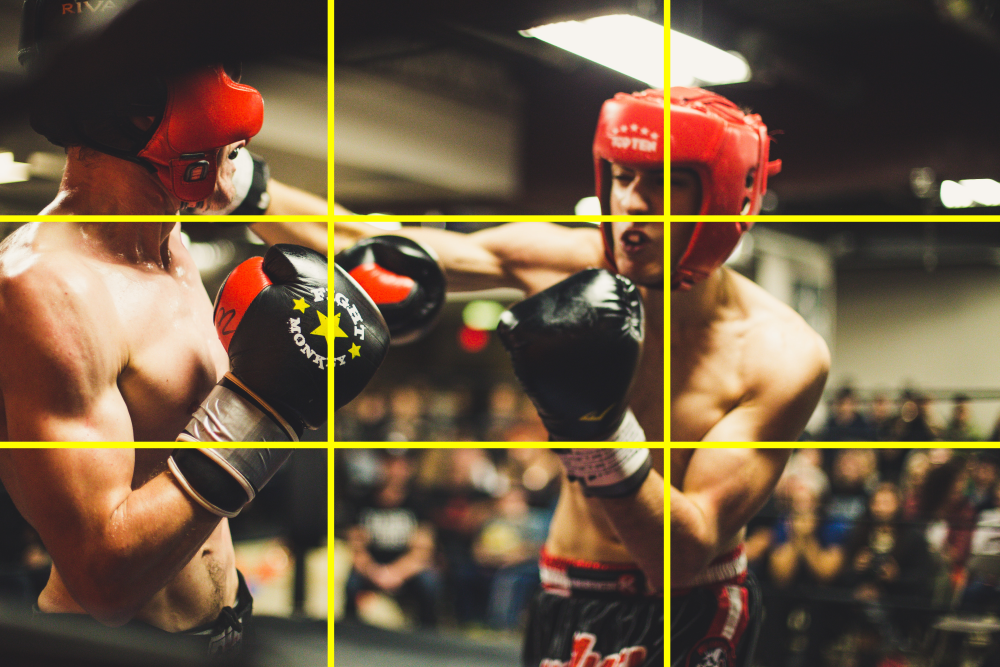
Try putting your points of interest at one of the four intersection points for a pleasing composition
Applying the Rule of Thirds in Landscape Photography
Taking a look at how to apply the rule of thirds with the landscape is the best starting point. Landscape photography relies heavily on the rule of thirds to enhance a scene and provide balance to the overall composition. Further to this, we will look at points of intersection working to lineup and highlight the points of interest in your frame.
A standard landscape scene may involve the land in the foreground with a clear horizon line and a beautiful cloudscape in the sky. A common approach to framing such a scene would be to line up the horizon line in the dead centre of the scene, so you get an equal amount of ocean and sky. This makes sense, as symmetry is generally pleasing to the eye.
To gain a higher level of balance and dynamic interest though, you could apply the rule of thirds. If the land in your scene was rather flat and expansive, yet the cloudscape was intense, you might want to consider including more of the sky and less of the sea. In this case you would you lower the horizon line to roughly match the bottom horizontal grid line so that the sky takes up two thirds of the image.
This composition suddenly gives the sky far higher prevalence and interest. The viewer has their eyes drawn more to the top two-thirds of the frame first before shifting to appreciate the rest of the image.
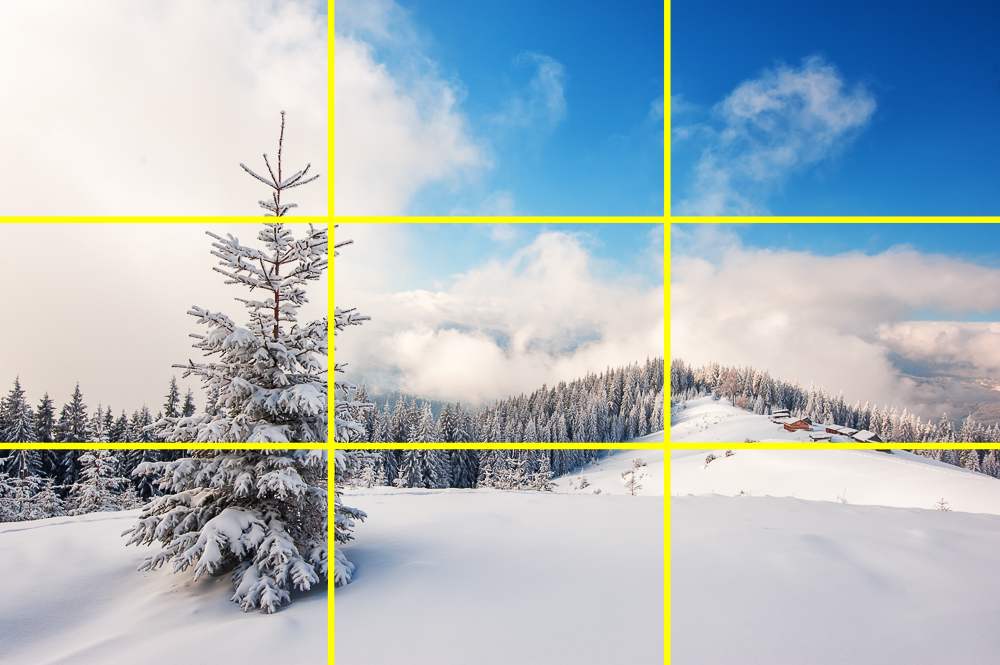
Aligning your horizon with either the upper or lower horizontal line depending on if you want more sky or land in your image. Note in this image the foreground tree is also roughly aligned with the left vertical line
An opposite example in landscape photography could be a lake in the foreground with a single dead tree sticking out of it. In the background is a gorgeous mountain range and the sky is rather flat and cloudless. The critical points of interest would be the tree in the lake and the mountain range in the distance. It is also essential to consider where the horizon line sits in the composition before you make any shooting decisions.
In applying the rule of thirds, you would want the tree and the lake to dominate the foreground. To do so, place the horizon line on the top horizontal grid line without losing the details of the mountain range. Next, place the tree on the bottom left intersection point rather than smack in the middle of the frame.
Suddenly you have a well balanced and dynamic image with your eye being drawn first from the tree in the lake and then across to the right to take in the lake and mountain range above it. The viewer's eye is now engaged in a motion that rotates around the compositions. Now hurry up and take the shot!
Applying the Rule of Thirds when Photographing People
Applying the rules of thirds is also used when photographing people. We have already identified that when shooting people up close, the key point of interest is usually the eyes. Rather than framing the person centrally, reposition so that the eyes sit over one of the top two points of intersection.
This can be expanded to shooting people in their larger environment. Imaging a couple was walking along a beach with a sunset forming in the top left corner. Composing the couple standing in the middle of the frame has no real interest, and your eye sticks in the middle of the image. Using the rule of thirds, place your points of interest - in this case the couple - to the bottom right intersection point of your frame. Your eye travels from the couple to the location of the sunset and the horizon line. That is the top-left point of intersection in your frame.
With the horizon line set at the same grid line as the sunset, your eye travels back across the top of the frame to the right where the couple is. You have created a far more compelling and dynamic scene. The story you are trying to tell is all the richer with the application of the rule of thirds.

Position your subject's eyes at one of the intersection points
Camera Settings when Applying the Rule of Thirds
For those of you that are relatively new to photography and want to practice applying the rule of thirds more, we recommend not getting too caught up in your camera settings. If shooting a landscape, you may choose to set your aperture anywhere from f8 to f16 and then set an appropriate shutter speed depending on the conditions. This way, you will have all elements, including your points of interest, in sharp focus. But our recommendation would be to focus first on applying the rule of thirds and not too much on specific camera settings, as the rule can apply to a wide variety of shots with wildly varying settings.
Once you are comfortable with applying the rule, you can start to experiment with different settings to change the emphasis on your points of interest. In the earlier scene where the single dead tree was sticking out of the lake, you could choose to focus on the tree and open your aperture to f2.8 or f4. The tree will be in sharp focus and will stand out compared to the softer and slightly blurred background of the mountains.
Again this will take practice, but the rewards will be well worth it. In applying the rule of thirds along with some careful consideration of camera settings, you can create a powerful image that speaks of balance and draws the viewer into the scene.
When is it OK to Break the Rule of Thirds?
While it is called the rule of thirds, rules were made to be broken! The rule of thirds is not an absolute concept that must apply every single time you pick up the camera.
In fact, the rule of thirds does not even apply in all scenarios. Nor does it apply to every genre of photographic style and pursuit. If anything, the most important thing to learn from the rule of thirds is not necessarily the rule itself, but the concept that you need to take a moment to stop and consider your scene, subjects, and points of interest so that you can frame the composition carefully.
Do all of this before you even bring that camera up to your eye. We guarantee you will be well on the way to stronger and more dynamic photography.
There are many situations and genres where either the rule of thirds does not apply or you choose to break it intentionally, and that's ok!
Looking for great camera gear so you can experiment with the rule of thirds in practice? Contact digiDirect and our friendly staff can help get you started on your photographic journey.















































































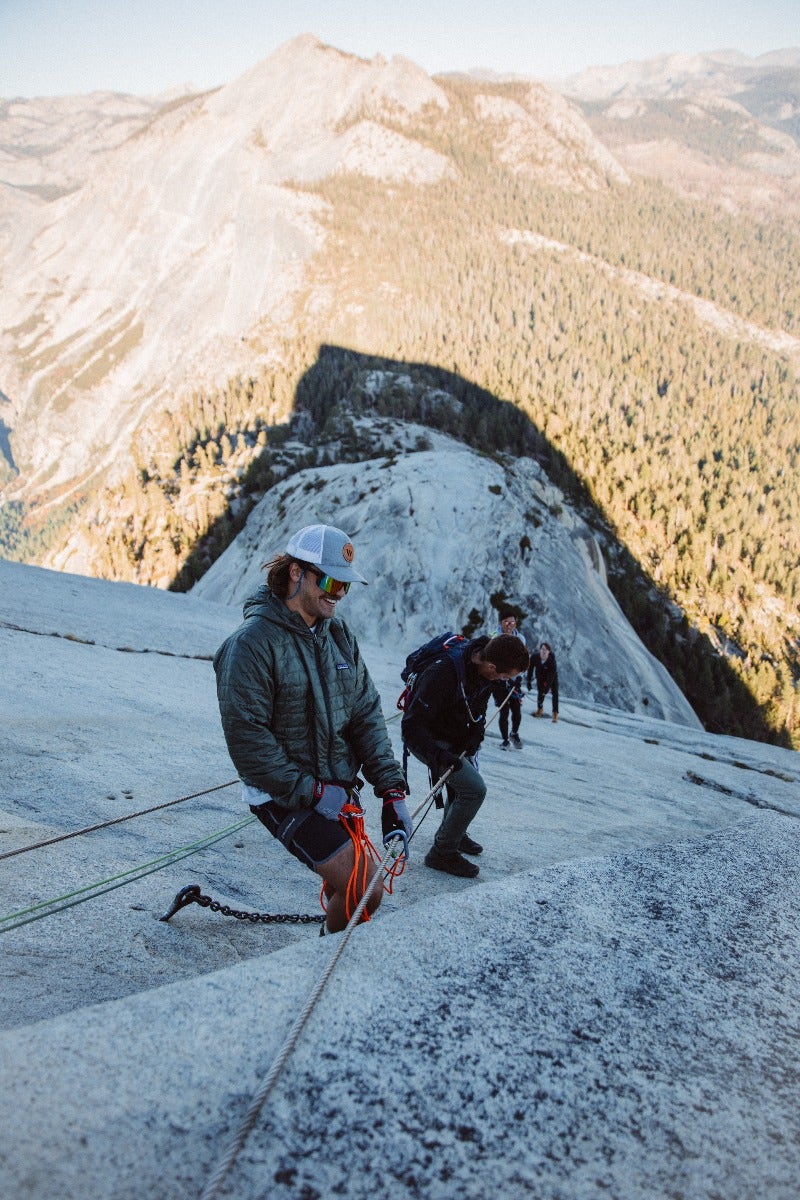

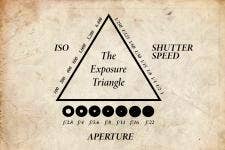

Comments
No Comments yet. Be the first to comment.